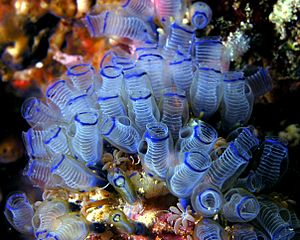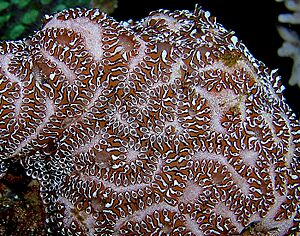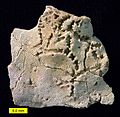Tunicate facts for kids
Quick facts for kids Tunicates |
|
|---|---|
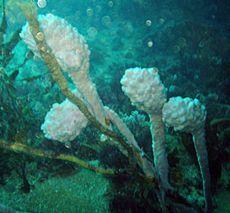 |
|
| Sea tulips, Pyura spinifera. A symbiotic sponge covers its surface. |
|
| Scientific classification | |
| Kingdom: | |
| Phylum: | |
| Subphylum: |
Tunicata
Giribet et al 2000
|
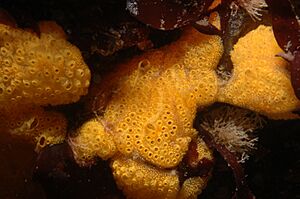
Tunicates, also known as sea squirts, are amazing sea animals. They are part of a larger group called Chordates, which includes animals with a notochord (a flexible rod supporting the body). Sea squirts get their name because they can squirt water when disturbed!
These creatures are filter-feeders. This means they eat tiny bits of food, like plankton, from the water. Adult tunicates are covered by a tough, leathery outer layer called a tunic. This tunic helps protect and support them.
Most adult tunicates are sessile, meaning they stay stuck to things like rocks on the sea floor. Many tunicates live in groups called colonies. There are about 3,000 different kinds of tunicates. They mostly live on the sea floor in coastal areas.
Contents
How Tunicates Eat
A sea squirt has two openings in its body. One opening is called the oral siphon. It sucks water into the animal. The other opening is called the atrial siphon. It squirts water out.
Inside the sea squirt is a special basket-like sieve. This sieve traps tiny food particles from the water. This is how sea squirts filter their food. They can also close their siphons tightly, like a drawstring bag.
The Tunicate Life Cycle
When a sea squirt is young, it is called a larva. It looks very different from an adult. The larva looks a bit like a tadpole and can swim around. This is why it's sometimes called a tadpole larva.
The larva swims for a short time. Then, it finds a good spot on the sea floor, like a rock. It attaches itself there and changes into its adult form. After this change, it usually stays in that one spot for the rest of its life.
Tunicate Family Tree
Tunicates are more closely related to animals with backbones, like fish and vertebrates, than they are to other invertebrates. This means they share a more recent common ancestor with us than with, say, starfish.
Amazing Discoveries
Scientists have found some interesting things in tunicates. Some species contain special Chemical substances. These chemicals might help fight diseases like cancer or different viruses.
Scientists have also learned that some tunicates can heal themselves. They can even fix damage over many generations. This process is very interesting and might help us understand healing in other animals, including humans.
Related Pages
- Salp: These are a type of tunicate that can form huge swarms in the ocean. They are often seen in the Southern Ocean near Antarctica.
Images for kids
-
The star-shaped holes (Catellocaula vallata) in this Upper Ordovician bryozoan may represent a tunicate preserved by bioimmuration in the bryozoan skeleton.
See also
 In Spanish: Urochordata para niños
In Spanish: Urochordata para niños


